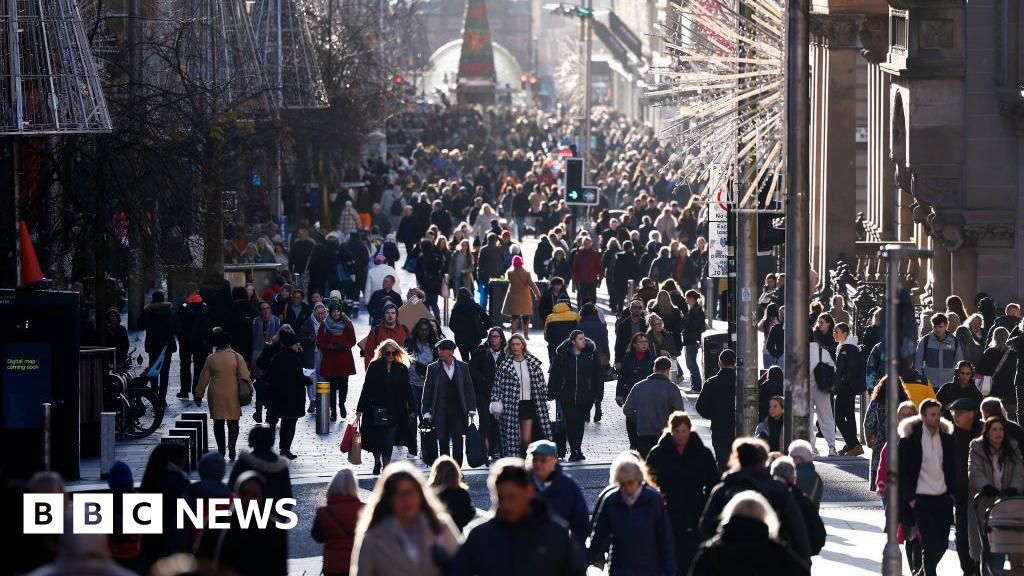Politics
Scotland’s Growing Population Driven by Migration Trends

Scotland’s population reached a record high of over 5.5 million last year, despite the fact that deaths have consistently outnumbered births for the past decade. This seemingly paradoxical growth can be attributed to significant net migration, with a notable influx of people moving to Scotland, primarily from overseas.
The latest figures from the National Records of Scotland (NRS) reveal that in the year leading up to mid-2024, approximately 124,600 people arrived in Scotland, while 68,200 departed. This results in a net migration figure of 56,400, with three-quarters of these newcomers hailing from outside the UK. Scottish ministers have emphasized that this trend is crucial for maintaining population growth, particularly as the country grapples with an aging demographic and declining birth rates.
The migration landscape in Scotland has shifted markedly in recent years. Historically, the narrative revolved around Scots leaving for opportunities elsewhere. However, since 1999, immigration has played a central role in population growth, with notable surges occurring during significant events like the expansion of the European Union in 2004 and the aftermath of Brexit in 2020.
The NRS reports that Scotland’s population grew by 144,400 (or 2.7%) between the 2011 and 2022 censuses. During this time, the number of individuals born in Scotland decreased by 90,400, a decline offset by an increase of 49,200 from the rest of the UK and 185,600 from overseas. This trend indicates that the natural change—defined as the difference between births and deaths—will likely continue to widen in the coming decades.
Inward migration is projected to bridge this gap. By 2047, Scotland’s population could reach as high as 5.8 million, according to NRS estimates. While 23 council areas are expected to experience population growth in the next decade, another nine areas may see declines if current demographic trends persist.
Equalities Minister Kaukab Stewart highlighted that positive net migration is essential for filling critical skill shortages in various sectors, including healthcare and agriculture. Notably, the increasing presence of international students has been a significant driver of this immigration surge. In the 2022/23 academic year, Scotland welcomed a record 83,975 international students, even as the number of EU students halved to 10,430 since Brexit.
China remains the leading source of international students, contributing 17,565 enrolments last year. The financial impact of these students is substantial, with estimates suggesting they have contributed between £4 billion and £6 billion to the Scottish economy since 2019. Nevertheless, a decline of over 10,000 overseas students last year has raised concerns for institutions heavily reliant on this demographic, such as Dundee University.
In addition to students, many individuals arrive in Scotland through pre-arranged work visas, encompassing a wide range of professions from international athletes to essential healthcare workers. The demand for health and care-related visas surged, tripling in recent years prior to a recent tightening of immigration rules. However, the full extent of skilled worker visa arrivals remains unclear.
The complexities of migration to Scotland also include individuals living without authorization, such as those who overstay holiday visas. The UK government has not assessed the number of unauthorized migrants in over two decades. Asylum seekers represent another facet of this immigration landscape, with around 6,107 individuals currently seeking refuge in Scotland, a statistic that has climbed alongside rising application numbers across the UK.
Scotland’s record of welcoming migrants is evident across all council areas. The largest increase in net migration was reported in Glasgow, which experienced a 1.8% growth, corresponding to 11,540 newcomers. Other areas such as Midlothian and Edinburgh also saw significant growth, with respective increases of 1.5% and 1.2%.
Research conducted by Ross Bond, a senior lecturer in sociology at the University of Edinburgh, indicates that around one in ten respondents in the recent census were born outside the UK, a substantial increase from 3.8% in 2001. The majority of these migrants are under the age of 25 and are primarily located in urban areas.
As Scotland continues to navigate the challenges and opportunities presented by migration, the balance of its population dynamics will play a critical role in shaping its future. The current trends underscore the importance of understanding and addressing the various factors that influence both immigration and the broader demographic landscape of the nation.
-

 Entertainment3 months ago
Entertainment3 months agoAnn Ming Reflects on ITV’s ‘I Fought the Law’ Drama
-

 Entertainment4 months ago
Entertainment4 months agoKate Garraway Sells £2 Million Home Amid Financial Struggles
-

 Health3 months ago
Health3 months agoKatie Price Faces New Health Concerns After Cancer Symptoms Resurface
-

 Entertainment3 months ago
Entertainment3 months agoCoronation Street’s Carl Webster Faces Trouble with New Affairs
-

 Entertainment2 months ago
Entertainment2 months agoWhere is Tinder Swindler Simon Leviev? Latest Updates Revealed
-

 Entertainment4 months ago
Entertainment4 months agoMarkiplier Addresses AI Controversy During Livestream Response
-

 Science1 month ago
Science1 month agoBrian Cox Addresses Claims of Alien Probe in 3I/ATLAS Discovery
-

 Entertainment4 months ago
Entertainment4 months agoKim Cattrall Posts Cryptic Message After HBO’s Sequel Cancellation
-

 Entertainment2 months ago
Entertainment2 months agoOlivia Attwood Opens Up About Fallout with Former Best Friend
-

 Entertainment3 months ago
Entertainment3 months agoMasterChef Faces Turmoil as Tom Kerridge Withdraws from Hosting Role
-

 Entertainment4 months ago
Entertainment4 months agoSpeculation Surrounds Home and Away as Cast Departures Mount
-

 World2 months ago
World2 months agoCole Palmer’s Mysterious Message to Kobbie Mainoo Sparks Speculation





















